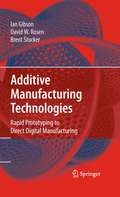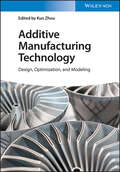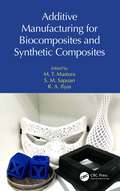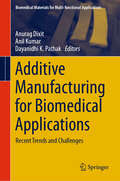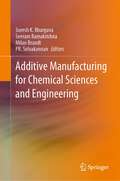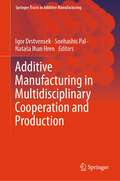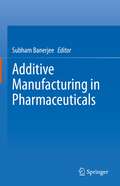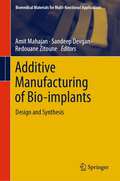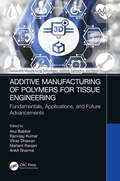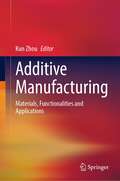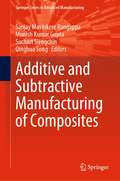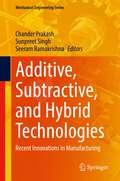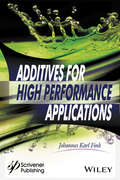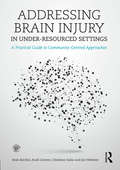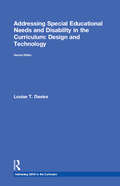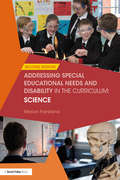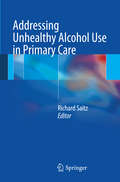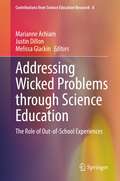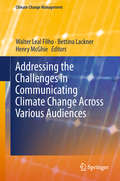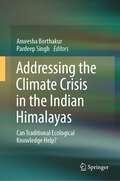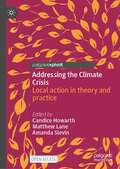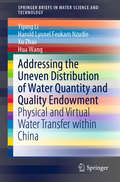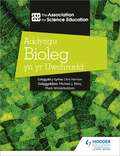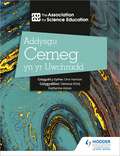- Table View
- List View
Additive Manufacturing Technologies: Rapid Prototyping to Direct Digital Manufacturing
by David W. Rosen Ian Gibson Brent StuckerAdditive Manufacturing Technologies: Rapid Prototyping to Direct Digital Manufacturing deals with various aspects of joining materials to form parts. Additive Manufacturing (AM) is an automated technique for direct conversion of 3D CAD data into physical objects using a variety of approaches. Manufacturers have been using these technologies in order to reduce development cycle times and get their products to the market quicker, more cost effectively, and with added value due to the incorporation of customizable features. Realizing the potential of AM applications, a large number of processes have been developed allowing the use of various materials ranging from plastics to metals for product development. Authors Ian Gibson, David W. Rosen and Brent Stucker explain these issues, as well as: Providing a comprehensive overview of AM technologies plus descriptions of support technologies like software systems and post-processing approaches Discussing the wide variety of new and emerging applications like micro-scale AM, medical applications, direct write electronics and Direct Digital Manufacturing of end-use components Introducing systematic solutions for process selection and design for AM Additive Manufacturing Technologies: Rapid Prototyping to Direct Digital Manufacturing is the perfect book for researchers, students, practicing engineers, entrepreneurs, and manufacturing industry professionals interested in additive manufacturing.
Additive Manufacturing Technology: Design, Optimization, and Modeling
by Kun ZhouAdditive Manufacturing Technology Highly comprehensive resource covering all key aspects of the current developments of additive manufacturing Additive Manufacturing Technology: Design, Optimization, and Modeling provides comprehensive and in-depth knowledge of the latest advances in various additive manufacturing technologies for polymeric materials, metals, multi-materials, functionally graded materials, and cell-laden bio-inks. It also details the application of numerical modeling in facilitating the design and optimization of materials, processes, and printed parts in additive manufacturing. The topics covered in this book include: Fundamentals and applications of 4D printing, 3D bioprinting of cell-laden bio-inks, and multi-material additive manufacturing Alloy design for metal additive manufacturing, mechanisms of metallurgical defect formation, and the mechanical properties of printed alloys Modified inherent strain method for the rapid prediction of residual stress and distortion within parts fabricated by additive manufacturing Modeling of the different stages in polymer and metal additive manufacturing processes, including powder spreading, melting, and thermal stress evolution By providing extensive coverage of highly relevant concepts and important topics in the field of additive manufacturing, this book highlights its essential role in Industry 4.0 and serves as a valuable resource for scientists, engineers, and students in materials science, engineering, and biomedicine.
Additive Manufacturing for Biocomposites and Synthetic Composites
by S. M. Sapuan R. A. Ilyas M. T. MasturaAdditive Manufacturing for Biocomposites and Synthetic Composites focuses on processes, engineering, and product design applications of bio-composites and synthetic composites in additive manufacturing (AM). It discusses the preparation and material characterization and selection, as well as future opportunities and challenges. Reviews the latest research on the development of composites for AM and the preparation of composite feedstocks Offers an analytical and statistical approach for the selection of composites for AM, including characterization of material properties Emphasizes the use of environmentally friendly composites Analyzes the lifecycle including costs Considers potential new fibers, their selection, and future applications This book provides a comprehensive overview of the application of advanced composite materials in AM and is aimed at researchers, engineers, and advanced students in materials and manufacturing engineering and related disciplines.
Additive Manufacturing for Biomedical Applications: Recent Trends and Challenges (Biomedical Materials for Multi-functional Applications)
by Anil Kumar Anurag Dixit Dayanidhi K. PathakNew fabrication techniques and biomaterials have advanced significantly as attention toward healthcare innovations in recent decades has increased. This book provides a comprehensive overview of the application of additive manufacturing for biomedical devices. The book focuses on the use of biomaterial for hard and soft tissue engineering. These materials can imitate the mechanical, structural, and biological characteristics of the parent tissue, repairing or replacing its functioning. It provides details on the use of various biomaterials for different biomedical applications. It highlights the present trends and potential of various techniques and materials for various applications. The chapters in this book written by eminent experts highlight recent developments in additive manufacturing for biological mimicking and surgical planning. It discusses latest advances in various 3D printing technologies in the fabrication of biomedical devices for orthopaedic and cardiovascular applications, along with rising trends in designing and creating tissue replacement substitute simulants. This book can serve as a fundamental textbook for research in additive manufacturing, fabrication of implants or scaffolds and medical device development, biomaterials, tissue engineering, and biomedical engineering. This book can be a valuable resource for mechanical and biomedical engineers, academicians, healthcare researchers, and professionals interested in tissue engineering.
Additive Manufacturing for Chemical Sciences and Engineering
by Seeram Ramakrishna Suresh K. Bhargava Milan Brandt Pr. SelvakannanThis book is tailored designed for both researchers as well as academics teaching or introducing Advanced Manufacturing course to their classrooms. It presents the current state of research in this field of research and major challenges identified so far, for the integration of additive manufacturing into chemical processes. Unique capability of transforming materials into functional devices with specific geometry using the emerging additive manufacturing technologies has stimulated significant interest in biology, engineering and materials science, to provide custom-made designs for tailored applications. However, the applications of this emerging technology in the field of chemical sciences and engineering have started very recently. Therefore, the major focus of this book is to introduce the basic principles of additive manufacturing practices as well as advent into conventional chemical processes and various unit operations. The potential advantage of introducing these additive manufacturing technologies has the potential to scale down large scale chemical processes into small scale, which offers several advantages including lower foot print, waste reduction and efficient heat integration as well as distributed chemical manufacturing.
Additive Manufacturing in Multidisciplinary Cooperation and Production (Springer Tracts in Additive Manufacturing)
by Igor Drstvensek Snehashis Pal Nataša Ihan HrenThis book publishes the latest findings and ideas in the field of additive manufacturing presented by authors from prominent institutions around the world at the iCAT 2023 conference. The authors address various technological and medical aspects, ranging from materials science to the specific behaviour of the technology under different working conditions. The book is divided into four sections, three of which are dedicated to the purely technological aspects of additive manufacturing, covering metal processes, polymer processes and simulation. The fourth part of the book is dedicated to the medical applications of additive manufacturing, covering areas ranging from orthopaedic surgeries to materials used in medical AM.Overall, the book provides insight into the current state of the science and applications of additive manufacturing.
Additive Manufacturing in Pharmaceuticals
by Subham BanerjeeThis book presents the different 3D/4D printing technological applications of Additive Manufacturing (AM) in Pharmaceutical Sciences. The initial chapter provides the historical perspective and current scenario of AM in pharmaceuticals. The book further discusses about different 3D printing platform technologies such as FDM, SLA, SLS, SSE, Ink-jet & binder jet principles & applications in developing advanced drug delivery systems. It also covers the methodology, materials for AM and important parameters associated with these platform technologies. The book highlights the progress and practical applications of 4D-printing technology in healthcare & pharmaceuticals fraternity as well including the essence of bioprinting in pharmaceuticals. Finally, the book reviews the regulatory guidelines, perspectives, and integration of Artificial Intelligence (AI)/Machine learning (ML) in pharmaceutical AM. This book is indeed a valuable resource for students, researchers/scholars, young start-ups/entrepreneurs, and pharmaceutical professionals by providing thorough detailing about AM in Pharmaceuticals.
Additive Manufacturing of Bio-implants: Design and Synthesis (Biomedical Materials for Multi-functional Applications)
by Redouane Zitoune Amit Mahajan Sandeep DevganThis contributed volume presents the latest research on additive manufacturing (AM) or 3D printing, one of the key techniques of novel medical devices, which can process complicated or customized structures to match the properties of human tissues. AM allows for the fabrication of devices with optimal architectures, complicated morphologies, surface integrity, and regulated porosity and chemical composition. Various AM methods can now consistently fabricate dense products for a variety of materials, comprising steels, titanium alloys, Co-Cr alloys, metal-based composites, and nanocomposites. This book elucidates the chronology of various techniques that are categorized under additive manufacturing. Moreover, the futuristic techniques or advancements in this area are also described. The available literature focuses on the microstructure and various properties of 3D-printed alloys. However, the research on the wear characteristics, corrosion resistance, and biocompatibility of 3D-printed technology for biomedical applications is limited. This book comprises the helicopter view of different surface analysis trends of additive manufactured alloys. The book can be a valuable reference for beginners, researchers, and professionals interested in bioimplant manufacturing and allied fields.
Additive Manufacturing of Polymers for Tissue Engineering: Fundamentals, Applications, and Future Advancements (Sustainable Manufacturing Technologies)
by Ankit Sharma Ranvijay Kumar Atul Babbar Vikas Dhawan Nishant RanjanApplication of additive manufacturing and tissue engineering in the fields of science and technology enables the manufacturing of biocompatible, customized, reliable, and cost-effective parts, restoring the functionality of a failed human body part. This book offers a platform for recent breakthroughs in additive manufacturing related to biomedical applications. This book highlights some of the top innovations and advances in additive manufacturing and processing technologies that are the future of the manufacturing industry while also presenting current challenges and opportunities regarding the choice of material. This book includes areas of applications such as surgical guides, tissue regeneration, artificial scaffolds, implants, and drug delivery and release. Throughout the book, an emphasis is placed on rapid tooling for engineering applications. Additive Manufacturing of Polymers for Tissue Engineering: Fundamentals, Applications, and Future Advancements acts as a first-hand source of information for academic scholars and commercial manufacturers as they make strategic manufacturing and development plans.
Additive Manufacturing: Materials, Functionalities and Applications
by Kun ZhouThis book focuses on the advances of additive manufacturing in the applications of wearable electronics, energy storage, biomedical implants and devices, drug delivery, and technologies for 4D printing, large-scale printing, and ceramics printing. It provides timely insights into the materials, functionalities, and applications of additive manufacturing.
Additive and Subtractive Manufacturing of Composites (Springer Series in Advanced Manufacturing)
by Munish Kumar Gupta Suchart Siengchin Sanjay Mavinkere Rangappa Qinghua SongThis book describes crucial aspects related to the additive and subtractive manufacturing of different composites. The first half of this book mainly deals with the various types of composite fabrication methods along with the introduction, features and mechanisms and also the processing of composite materials via additive manufacturing route. Also, the thermal, mechanical, physical and chemical properties relevant to the processing of composite materials are included in the chapters. The second half of this book primarily demonstrates an extensive section on the different types of additive manufacturing processes like selective laser sintering, selective laser melting, stereolithography, fused deposition modeling and material jetting used to fabricate the metals and polymers. Also, the chapters address the complete description of fabrication processes for metal matrix composites and polymer matrix composites. Moreover, the different methods adopted such as short peening, micro-machining, heat-treatment and solution treatment to improve the surface improvement are well discussed. This book gives many helps to researchers and students in the fields of the additive and subtractive manufacturing of different composites.
Additive, Subtractive, and Hybrid Technologies: Recent Innovations in Manufacturing (Mechanical Engineering Series)
by Seeram Ramakrishna Chander Prakash Sunpreet SinghThis book provides readers with the comprehensive insights of the recent research breakthroughs in additive, subtractive, and hybrid technologies. Further, the book examines incomparable design and manufacturing independences, as well as strategies to upgrade the product performance characteristics through collaborating additive and subtractive technologies. Indeed, the intrinsic benefits and limitations of both additive and subtractive manufacturing technologies could be merged to obtain appreciable hybridizations. The editorial team members and contributors to Additive, Subtractive, and Hybrid Technologies are highly motivated experts committed to and the advance of hybrid manufacturing technologies.
Additives for High Performance Applications: Chemistry and Applications
by Johannes Karl FinkThis book focuses on the chemistry of additives for high performance applications and a large number of chemical formulas are displayed in the text. The additives applications include: Analysis and separation techniques, such as high performance liquid chromatography, for example ionic liquids. Additives for electrical applications, such as capacitors, electrokinetic micropumps, lithium-ion batteries, and other battery types. Additives for solar cells for control of the active layer nanomorphology are documented as are additives for electrolyte membranes, fuel cells, such as membrane exchange humidifiers and coolant additives. Medical applications include high performance additives for the manufacture of scaffolds, controlled drug release, and nanofibers. Additives for lubricants including the deposit control, anti-wear additives, fluid loss control additives in drilling applications. Additives for concrete uses such as set retarders, curing accelerators, defoamers, permeability control additives, and corrosion protection additives.
Addressing Brain Injury in Under-Resourced Settings: A Practical Guide to Community-Centred Approaches
by Rudi Coetzer Ross Balchin Christian Salas Janice WebsterMany of the world’s population have no access to appropriate diagnostic, neurorehabilitative or support services following brain injury. Addressing Brain Injury in Under-Resourced Settings: A Practical Guide to Community-Centred Approaches tackles this unacceptable gap in service provision by empowering the reader to provide basic care, education and support for patients with brain injuries and their families. Written for an audience which does not necessarily have any prior knowledge of the brain, neurorehabilitation or brain injuries/pathologies, this practical guide first examines the global context of brain injury, considering the cross-cultural realities across communities worldwide. The book goes on to explore the reality of brain injury and how to work with its consequences, offering practical knowledge and advice in a user-friendly, richly illustrated format. It provides easily digestible information about the brain, including its normal functioning and the ways in which it can be damaged through injury and disease. The book also covers the basic skills needed to identify neurological difficulties and provides guidance on basic rehabilitation input and support. The final section of the book covers how to provide services, including working with organisations and communities, volunteering, initiating and developing community-based projects and programmes, and caring for patients and their families from emergency to recovery to rehabilitation. This book is an invaluable resource for community health workers, voluntary sector workers and all professional healthcare providers who work with brain-injured patients around the world. It will also be important reading for policy developers, fundraising organisations and those who work with global humanitarian initiatives.
Addressing Special Educational Needs and Disability in the Curriculum: Design And Technology (Addressing SEND in the Curriculum)
by Louise T. DaviesThe SEND Code of Practice (2015) reinforced the requirement that all teachers must meet the needs of all learners. This topical book provides practical, tried-and-tested strategies and resources that will support teachers in making design and technology lessons accessible and interesting for all pupils, including those with special educational needs. The author draws on a wealth of experience to share her understanding of special educational needs and disabilities and show how the design and technology teacher can reduce or remove any barriers to learning. Offering strategies that are specific to the context of design and technology teaching, this book will enable teachers to: better identify a student’s particular learning requirements; set inclusive design and making assignments which allow all students to participate and succeed; build students’ confidence in using a range of materials and tools; assist with design tasks where pupils take ownership of their work and learning; adapt the classroom environment to meet the needs of pupils; create a mutually supportive classroom which maximises learning opportunities. An invaluable tool for continuing professional development, this text will be essential for design and technology teachers (and their teaching assistants) seeking to include and motivate all pupils in their lessons, regardless of their individual needs. This book will also be of interest to secondary SENCOs, senior management teams and ITT providers. In addition to free online resources, a range of appendices provide design and technology teachers with a variety of pro forma and activity sheets to support effective teaching. This is an essential tool for design and technology teachers and teaching assistants, and will help to deliver successful, inclusive lessons for all pupils.
Addressing Special Educational Needs and Disability in the Curriculum: Science (Addressing SEND in the Curriculum)
by Marion FranklandThe SEND Code of Practice (2015) reinforced the requirement that all teachers must meet the needs of all learners. This topical book provides practical, tried and tested strategies and resources that will support teachers in making science lessons accessible and exciting for all pupils, including those with special needs. The author draws on a wealth of experience to share her understanding of special educational needs and disabilities and show how science teachers can reduce or remove any barriers to learning. Offering strategies that are specific to the context of science teaching, this book will enable teachers to: help all students develop their ‘evidence-gathering’ skills and aid their scientific discovery by involving the use of all of the senses and structuring tasks appropriately; create a supportive environment that maximises learning opportunities; plan the classroom layout and display to enhance learning; use technology to adapt lessons to the needs of individual pupils; successfully train and fully use the support of their teaching assistants. An invaluable tool for continuing professional development, this text will be essential for teachers (and their teaching assistants) seeking guidance specific to teaching science to all pupils, regardless of their individual needs. This book will also be of interest to SENCOs, senior management teams and ITT providers. In addition to free online resources, a range of appendices provide science teachers with a variety of writing frames and activity sheets to support effective teaching. This is an essential tool for science teachers and teaching assistants, and will help to deliver successful, inclusive lessons for all pupils.
Addressing Unhealthy Alcohol Use in Primary Care
by Richard SaitzWhile there is a wealth of published information on addiction medicine, the psychological aspects of alcohol abuse, and behavioral medicine with regard to addiction, virtually none of these resources were written with the primary care provider in mind. Addressing Unhealthy Alcohol Use in Primary Care is a resource for primary care clinicians who are confronted by patients with these problems daily, and who wish to successfully address these issues in their practice. It would focus on the literature and science relevant to primary care practice and cover the range of interventions appropriate for this setting. Topics include assessment, brief counseling interventions, pharmacotherapy, referrals to both specialty care and Alcoholics Anonymous (and other self-help programs), psychiatric co-morbidity and other drug use, and other information specific to the needs of the primary care provider.
Addressing Wicked Problems through Science Education: The Role of Out-of-School Experiences (Contributions from Science Education Research #8)
by Justin Dillon Marianne Achiam Melissa GlackinThis book discusses a number of ways in which out-of-school science education can uniquely engage learners with ‘wicked’ global problems such as biodiversity loss and climate change. The idea for the volume originated in discussions among members of the ESERA special interest group on "Science Education in Out-of-School contexts". It emerged from these discussions that out-of-school institutions and experiences offer opportunities for critical engagement in wicked problems that go far beyond what is possible solely in the science classroom.The book opens with a principled discussion of the nature of wicked problems and what addressing them involves. This introduction clarifies key terms and ideas to create a coherent backdrop for the rest of the book. Subsequent chapters discuss the challenges of designing educational experiences to address wicked problems, as well as the teaching and learning that takes place. The authors offer perspectives across a range of out-of-school environments such as science centres, natural history museums, botanical gardens, geological sites, and local communities. The book concludes with a chapter that synthesises the findings from the various contributions and points to the messages for educators. Finally, the editors outline an exciting research agenda to build knowledge of education addressing wicked problems. The intended audience of the book includes teachers, educators/facilitators, teacher educators, curriculum developers, and early career researchers as well as established researchers.
Addressing the Challenges in Communicating Climate Change Across Various Audiences (Climate Change Management)
by Walter Leal Filho Henry McGhie Bettina LacknerThis book offers a concrete contribution towards a better understanding of climate change communication. It ultimately helps to catalyse the sort of cross-sectoral action needed to address the phenomenon of climate change and its many consequences. There is a perceived need to foster a better understanding of what climate change is, and to identify approaches, processes, methods and tools which may help to better communicate it. There is also a need for successful examples showing how communication can take place across society and stakeholders. Addressing the challenges in communicating to various audiences and providing a platform for reflections, it showcases lessons learnt from research, field projects and best practices in various settings in various different countries. The acquired knowledge can be adapted and applied to other situations.
Addressing the Climate Crisis in the Indian Himalayas: Can Traditional Ecological Knowledge Help?
by Pardeep Singh Anwesha BorthakurThis book focuses on the traditional ecological knowledge in addressing the current climate crisis in the Indian Himalayas. Local or indigenous people in the Himalayas, through their low-carbon producing lifestyles, contribute very little to the climate crisis. However, at the same time, they bear the brunt of this crisis way more than many others. It is important to learn about their traditional ways of life and the knowledge that they hold regarding ecology and environment. Traditional ecological knowledge and associated belief systems are given increasing attention across the globe in recent times toward addressing some of the grave environmental concerns. Climate change is one such concern. The rising consideration of concepts such as ethnoecology and ethnobotany signifies the scientific, socio-cultural and economic potential of the traditional ecological knowledge systems. It is indisputable that these knowledge systems have the ability to provide important insights towards tackling many present-day environmental distresses including several climate change challenges. In this book, the authors concentrate on such traditional ecological knowledge systems in the Indian Himalayan region and try to figure out their significance in relation to the modern science. Overall, the authors attempt to write a book where the relevance of traditional ecological knowledge systems could be addressed and communicated to a larger audience—both academic scientific and non-academic.
Addressing the Climate Crisis: Local action in theory and practice
by Amanda Slevin Matthew Lane Candice HowarthThis open access book brings together a collection of cutting-edge insights into how action can and is already being taken against climate change at multiple levels of our societies, amidst growing calls for transformative and inclusive climate action. In an era of increasing recognition regarding climate and ecological breakdown, this book offers hope, inspiration and analyses for multi-level climate action, spanning varied communities, places, spaces, agents and disciplines, demonstrating how the energy and dynamism of local scales are a powerful resource in turning the tide. Interconnected yet conceptually distinct, the book’s three sections span multiple levels of analysis, interrogating diverse perspectives and practices inherent to the vivid tapestry of climate action emerging locally, nationally and internationally. Delivered in collaboration with the UK’s ‘Place-Based Climate Action Network’, chapters are drawn from a wide range of authors with varying backgrounds spread across academia, policy and practice.
Addressing the Uneven Distribution of Water Quantity and Quality Endowment: Physical and Virtual Water Transfer within China (SpringerBriefs in Water Science and Technology)
by Hua Wang Yiping Li Xu Zhao Harold Lyonel Feukam NzudieThis book presents a selected literature review and case studies for both physical and virtual water transfer. It offers an overview to showcase the interprovincial physical and virtual water transfer within China, and then demonstrates the effects of both approaches in dealing with regional water scarcity; the three cases presented in the Yangtze River Basin demonstrate the role of physical water transfer in improving water quality and restoring water ecosystems; while a Shanghai case highlights the impact of Shanghai’s virtual water import on water quantity and quality stress to other regions. This book promotes systematic approaches combining both virtual and physical water transfer solutions to deal with water quantity and quality issues. The book is intended for senior undergraduates, graduate students, lecturers and researchers in water management.
Addysgu Bioleg yn yr Uwchradd (Teaching Secondary Biology 3rd Edition Welsh Language edition)
by The Association EducationEnhance your teaching with expert advice and support for Key Stages 3 and 4 Biology from the Teaching Secondary series - the trusted teacher's guide for NQTs, non-specialists and experienced teachers.Written in association with ASE, this updated edition provides best practice teaching strategies from academic experts and practising teachers.- Refresh your subject knowledge, whatever your level of expertise- Gain strategies for delivering the big ideas of science using suggested teaching sequences- Engage students and develop their understanding with practical activities for each topic- Enrich your lessons and extend knowledge beyond the curriculum with enhancement ideas- Improve key skills with opportunities to introduce mathematics and scientific literacy highlighted throughout- Support the use of technology with ideas for online tasks, video suggestions and guidance on using cutting-edge software- Place science in context; this book highlights where you can apply science theory to real-life scenarios, as well as how the content can be used to introduce different STEM careersAlso available: Teaching Secondary Chemistry, Teaching Secondary Physics
Addysgu Bioleg yn yr Uwchradd (Teaching Secondary Biology 3rd Edition Welsh Language edition)
by The Association EducationEnhance your teaching with expert advice and support for Key Stages 3 and 4 Biology from the Teaching Secondary series - the trusted teacher's guide for NQTs, non-specialists and experienced teachers.Written in association with ASE, this updated edition provides best practice teaching strategies from academic experts and practising teachers.- Refresh your subject knowledge, whatever your level of expertise- Gain strategies for delivering the big ideas of science using suggested teaching sequences- Engage students and develop their understanding with practical activities for each topic- Enrich your lessons and extend knowledge beyond the curriculum with enhancement ideas- Improve key skills with opportunities to introduce mathematics and scientific literacy highlighted throughout- Support the use of technology with ideas for online tasks, video suggestions and guidance on using cutting-edge software- Place science in context; this book highlights where you can apply science theory to real-life scenarios, as well as how the content can be used to introduce different STEM careersAlso available: Teaching Secondary Chemistry, Teaching Secondary Physics
Addysgu Cemeg yn yr Uwchradd (Teaching Secondary Chemistry 3rd Edition Welsh Language edition)
by The Association EducationEnhance your teaching with expert advice and support for Key Stages 3 and 4 Chemistry from the Teaching Secondary series - the trusted teacher's guide for NQTs, non-specialists and experienced teachers.Written in association with ASE, this updated edition provides best practice teaching strategies from academic experts and practising teachers.- Refresh your subject knowledge, whatever your level of expertise- Gain strategies for delivering the big ideas of science using suggested teaching sequences- Engage students and develop their understanding with practical activities for each topic- Enrich your lessons and extend knowledge beyond the curriculum with enhancement ideas- Improve key skills with opportunities to introduce mathematics and scientific literacy highlighted throughout- Support the use of technology with ideas for online tasks, video suggestions and guidance on using cutting-edge software- Place science in context; this book highlights where you can apply science theory to real-life scenarios, as well as how the content can be used to introduce different STEM careersAlso available: Teaching Secondary Biology, Teaching Secondary Physics
